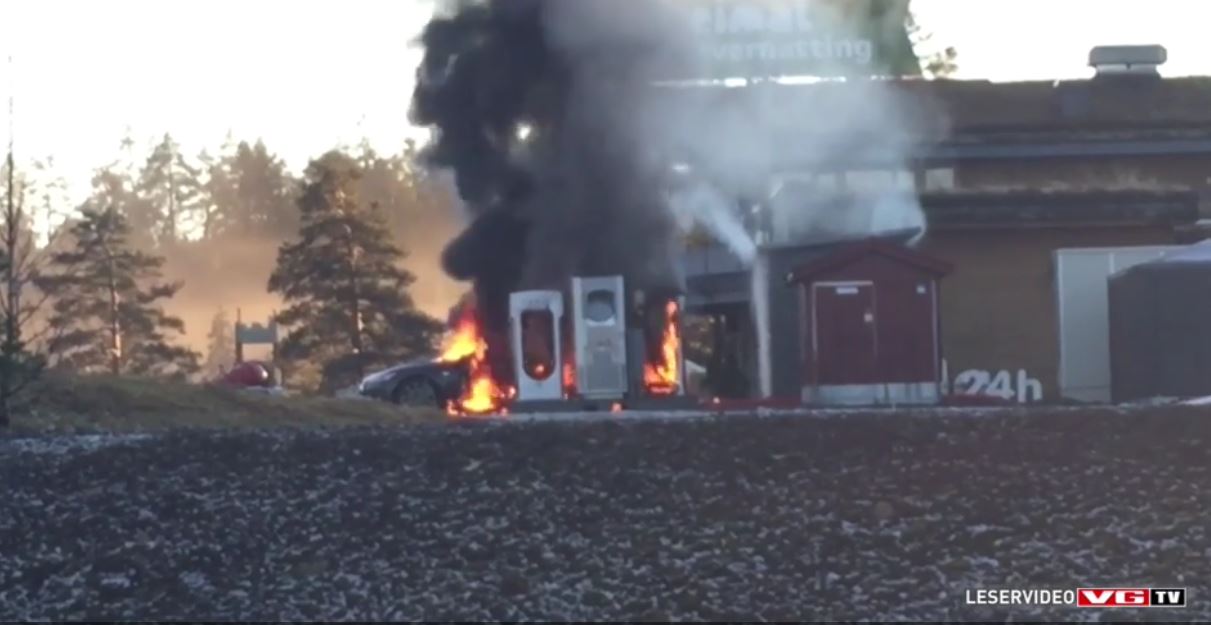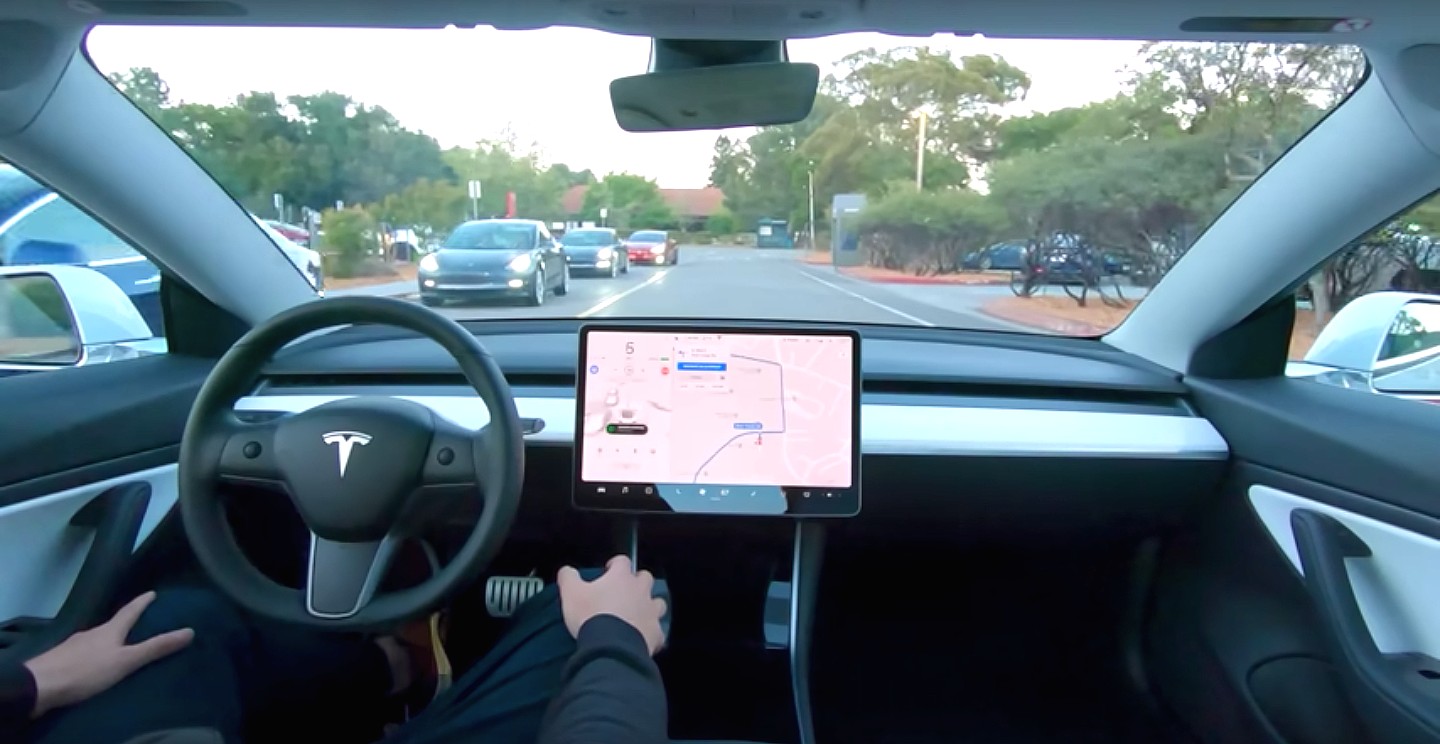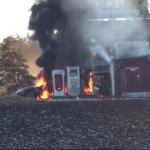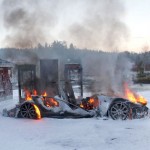

News
Tesla Identifies Cause for Model S Fire in Norway
After an exhaustive investigation, Tesla Motors has determined that the fire in a Model S in Norway last January was caused by a short circuit inside the electrical distribution box. A software upgrade is planned shortly.
After an exhaustive inquiry, Tesla Motors has determined the cause for the fire that engulfed a Tesla Model S while it was charging at a Supercharger station in Norway. The culprit – a short circuit in the electrical distribution box inside the vehicle according to Norwegian news site VG.
Tesla Communication Manager in Norway, Even Sandvold Roland, tells VG via e-mail, “In January, it was an isolated incident where a Model S caught fire while it used a Supercharger. The cause was a short circuit in the distribution box in the car. Superchargers were turned off immediately when the short circuit was discovered. No one was injured in the fire. Our investigation confirmed that this was an isolated incident, but due to the damage to the car, we could not definitely identify the exact cause of the short circuit.”.
Jan 1, 2016 – Tesla Model S burns to the ground while fast-charging at the Sundebru Supercharger in Gjerstad, Norway. [Source: VG]
Tesla pointed out that its vehicles have used Tesla Supercharger stations safely more than 2.5 million times. In addition, more than 35 million charging sessions have been completed safely and successfully using either home or destination chargers. Nevertheless, the company says it will update the software package in the Model S to provide extra security during charging. It tells VG the update will include a diagnostic solution to prevent charging if a potential short circuit is detected.
The cause of the fire could not be pinpointed further due to the extensive damage to the car. Norwegian firefighters, concerned for their own safety during their first encounter with a burning electric car, allowed the fire to burn itself out while protecting surrounding buildings with fire retardant foam.
The Norwegian Directorate for Civil Protection and Emergency Planning (DSB) was involved in the investigation of the fire. It had several meetings with Tesla representatives and is convinced this was an isolated incident. There is no reason to over-dramatize the event, they concluded.
DSB chief engineer Jostein Ween Dig told VG, “We are confident that this is a special event. A car fire is often spectacular, but there is no reason to believe that electric cars burn more often than other cars. Statistics actually indicate that incidence of fires is lower for electric cars, he said.
Actually, the fire was a “kinder” event than a fossil fuel fire, Dig said. “The owner had time to run back, unplug the charger connector and remove his possessions from the car. It took several minutes before the car was ablaze. Normally an electric vehicle fire is not as explosive as it can be in a petrol car. The flames you see in the picture and video were mostly from plastic in the interior that caught fire.” He emphasized that the battery did not explode.
Norwegian officials seem satisfied that Tesla automobiles and Supercharger stations pose no unusual risks of fire. The Supercharger location is now back in full operation and doing business as usual.
Special thanks to Leif Hansen in Norway for alerting us to the VB news story.
Photo Credit: VB News

News
Tesla Giga Berlin is still ramping production to meet Model Y demand: plant manager
Tesla Gigafactory Berlin has expanded to two full shifts, as per the facility’s plant manager, and a lot of it is due to Model Y demand.

Tesla Gigafactory Berlin has expanded to two full shifts, as per the facility’s plant manager, and a lot of it is due to Model Y demand. While registrations in some countries such as Sweden have fallen sharply this year, the company’s sales in other key territories have been rising.
Giga Berlin shifts to two shifts
Giga Berlin factory manager André Thierig told the DPA that the facility has been running two shifts since September to manage a surge in global orders. And due to the tariff dispute with the United States, vehicles that are produced at Giga Berlin are now being exported to Canada.
“We deliver to well over 30 markets and definitely see a positive trend there,” Thierig said.
Despite Giga Berlin now having two shifts, the facility’s production still needs to ramp up more. This is partly due to the addition of the Tesla Model Y Performance and Standard, which are also being produced in the Grunheide-based factory. Interestingly enough, Giga Berlin still only produces the Model Y, unlike other factories like Gigafactory Texas, the Fremont Factory, and Gigafactory Shanghai, which produce more than one type of vehicle.
Norway’s momentum
Norway, facing an imminent tax increase on cars, has seen a historic spike in Tesla purchases as buyers rush to secure deliveries before the change takes effect, as noted in a CarUp report. As per recent reports, Tesla has broken Norway’s all-time annual sales record this month, beating Volkswagen’s record that has stood since 2016.
What is rather remarkable is the fact that Tesla was able to achieve so much in Norway with one hand practically tied behind its back. This is because the company’s biggest sales draw, FSD, remains unavailable in the country. Fortunately, Tesla is currently hard at work attempting to get FSD approved for Europe, a notable milestone that should spur even more vehicle sales in the region.
News
Tesla launches crazy Full Self-Driving free trial: here’s how you can get it

Tesla is launching a crazy Full Self-Driving free trial, which will enable owners who have not purchased the suite outright to try it for 30 days.
There are a handful of stipulations that will be needed in order for you to qualify for the free trial, which was announced on Thursday night.
Tesla said the trial is for v14, the company’s latest version of the Full Self-Driving suite, and will be available to new and existing Model S, Model 3, Model X, Model Y, and Cybertruck owners, who will have the opportunity to try the latest features, including Speed Profiles, Arrival Options, and other new upgrades.
🚨 Tesla is launching a free 30-day trial of Full Self-Driving in North America for owners.
It includes every model, but you need v14.2 or later, and you cannot have already purchased the suite outright. https://t.co/8CNmxxOkVl
— TESLARATI (@Teslarati) November 27, 2025
You must own one of the five Tesla models, have Full Self-Driving v14.2 or later, and have an eligible vehicle in the United States, Puerto Rico, Mexico, or Canada.
The company said it is a non-transferable trial, which is not redeemable for cash. Tesla is reaching out to owners via email to give them the opportunity to enable the Full Self-Driving trial.
Those who are subscribed to the monthly Full Self-Driving program are eligible, so they will essentially get a free month of the suite.
Once it is installed, the trial will begin, and the 30-day countdown will begin.
Tesla is making a major push to increase its Full Self-Driving take rate, as it revealed that about 12 percent of owners are users of the program during its recent earnings call.
Tesla CFO Vaibhav Taneja said during the call:
“We feel that as people experience the supervised FSD at scale, demand for our vehicles, like Elon said, would increase significantly. On the FSD adoption front, we’ve continued to see decent progress. However, note that the total paid FSD customer base is still small, around 12% of our current fleet.”
Earlier today, we reported on Tesla also launching a small-scale advertising campaign on X for the Full Self-Driving suite, hoping to increase adoption.
Tesla Full Self-Driving warrants huge switch-up on essential company strategy
It appears most people are pretty content with the subscription program. It costs just $99 a month, in comparison to the $8,000 fee it is for the outright purchase.
News
Tesla Full Self-Driving warrants huge switch-up on essential company strategy

Tesla Full Self-Driving has warranted a huge switch-up on an essential company strategy as the automaker is hoping to increase the take rate of the ADAS suite.
Unlike other automotive companies, Tesla has long been an outlier, as it has famously ditched a traditional advertising strategy in favor of organic buzz, natural word-of-mouth through its production innovation, and utilizing CEO Elon Musk’s huge social media presence to push its products.
Tesla has taken the money that it would normally spend on advertising and utilized it for R&D purposes. For a long time, it yielded great results, and ironically, Tesla saw benefits from other EV makers running ads.
Tesla counters jab at lack of advertising with perfect response
However, in recent years, Tesla has decided to adjust this strategy, showing a need to expand beyond its core enthusiast base, which is large, but does not span over millions and millions as it would need to fend off global EV competitors, which have become more well-rounded and a better threat to the company.
In 2024 and 2025, Tesla started utilizing ads to spread knowledge about its products. This is continuing, as Full Self-Driving ads are now being spotted on social media platforms, most notably, X, which is owned by Musk:
NEWS: Tesla is running paid advertisements on X about FSD (Supervised). Here’s an ad they started running yesterday: pic.twitter.com/IHVywLMyTd
— Sawyer Merritt (@SawyerMerritt) November 25, 2025
Interestingly, Tesla’s strategy on FSD advertising is present in Musk’s new compensation package, as the eleventh tranche describes a goal of achieving 10 million active paid FSD subscriptions.
Full Self-Driving is truly Tesla’s primary focus moving forward, although it could be argued that it also has a special type of dedication toward its Optimus robot project. However, FSD will ultimately become the basis for the Robotaxi, which will enable autonomous ride-sharing across the globe as it is permitted in more locations.
Tesla has been adjusting its advertising strategy over the past couple of years, and it seems it is focused on more ways to spread awareness about its products. It will be interesting to see if the company will expand its spending even further, as it has yet to put on a commercial during live television.
We wouldn’t put it out of the question, at least not yet.












